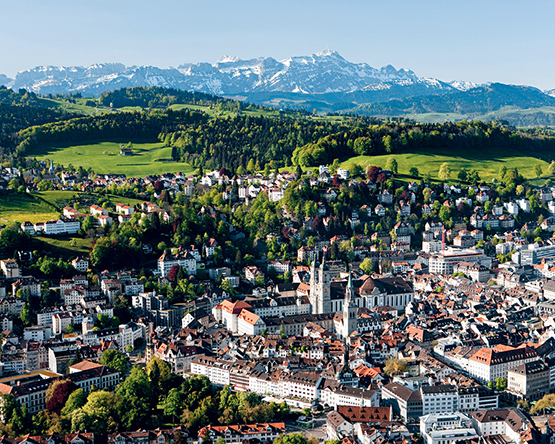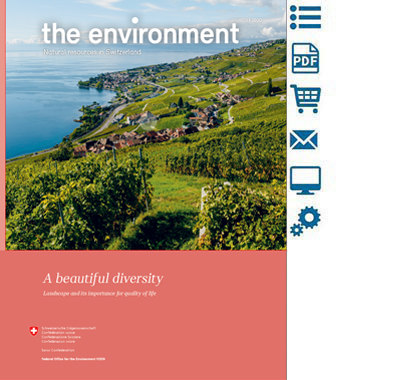How do you determine the quality of a landscape? One way is to assess landscape elements such as forests,settlements and bodies of water. The FOEN also teams up with the Swiss Federal Institute for Forest, Snowand Landscape Research (WSL) to gauge the views of the Swiss public as part of the Swiss Landscape Monitoring Programme (LABES), which records and monitors both the physical characteristics of the landscape and the way that people perceive it.
Text: Peter Bader

© swiss-image.ch | Christof Sonderegger
Do you have a favourite landscape? Open spaces with fields and meadows, perhaps? Or would it have to include forests – somewhere to escape to? Do you like living near water? Maybe you prefer urban environments? Or is mountain scenery your top priority because it reminds you of the place where you grew up? Landscapes – which include building culture (Baukultur) and biodiversity – are important for quality of life and for connecting people to where they live. A high quality of life is inextricably linked to a high-quality landscape. The European Landscape Convention, adopted in 2000, states that the landscape is a “key element” of individual and social well-being.
Objective perception?
Given the great importance of the landscape, monitoring and assessing changes to it is vital. How-ever, this is a challenging task because landscape change is often gradual and can only be recorded if suitable indicators can be collected in the same way over an extended period. Describing the landscape based on its physical characteristics is comparatively easy. But a landscape can only be considered of high quality if it is also rated positively by the people who live in it, says Gilles Rudaz of the FOEN’s Landscape Policy Section. “Landscape quality is not defined solely according to the spatial mosaic of natural and cultural elements, but primarily by how we humans perceive and judge that mosaic.”
Among other things, people tend to find landscapes beautiful if they have acquired special significance for them during their lives and through their socialisation. The perception of landscape is also shaped by individual needs and interests. This raises the question of whether there is such a thing as an objectively measurable perception of landscapes, which can form the basis for a generally applicable quality assessment. According to Marcel Hunziker, a specialist in social sciences in landscape research at WSL, the answer is: “Yes and no.” Perceived landscape quality is essentially a subjective judgement shaped by individual preferences and personal socialisation. However, this shaping, and hence the resulting landscape assessment, are not entirely arbitrary because “people with similar socialisation tend to think in a similar way and therefore make similar judgements”. This “intersubjective agreement” is greater than one might think, Hunziker says. In addition, certain landscape structures and features have widespread appeal for people around the world, such as the typical mix of open land and clusters of trees found in traditional Swiss countryside, as well as rivers and lakes.
Switzerland at the forefront
It is a core task of the Confederation, cantons and communes to conserve and enhance landscape qualities in the face of a steadily growing population and the associated increase in development. Reliable information about the current state and ongoing change processes provides the foundation for an effective landscape policy. “Switzerland is a world leader in monitoring the development of landscape quality because it recognises that landscape quality cannot be gauged solely by physical characteristics but also has to incorporate the way these characteristics are viewed by society”, explains Hunziker.
The LABES programme has been recording the state of the Swiss landscape since 2007. It sees the FOEN work in tandem with WSL, where Felix Kienast and Marcel Hunziker are responsible for methodological development and implementation. About 40 indicators are used to assess landscape quality. These include physical description indicators (e.g. land cover, land use, flowing and standing waters, wetlands and protected areas, light pollution), for which LABES draws on data from the land-use statistics and the Federal Office of Topography (swisstopo), as well as evaluating satellite images and agricultural data sources.
In addition, regular surveys representative of the entire Swiss population are conducted, covering various aspects of perception. These include the “landscape beauty” of a place, as articulated by the people that live there, and “landscape distinctiveness,” which indicates whether “a landscape stands out in people’s perception because of its distinctive qualities”.
High satisfaction rate among Swiss population
According to the LABES final report from 2017,the population rates Switzerland’s landscape quality “rather highly”. It is striking that communes in the Alps do particularly well, significantly more so than those in the Swiss Plateau and to the south of the Alps. In addition, rural communes score especially highly on authenticity, i.e. the degree to whichresidents identify with where they live and the surrounding area.
Generally speaking, towns and cities are also viewed favourably by the public, Hunziker notes. “The most negative perceptions relate to suburban areas on the outskirts of cities and more outlying peri-urban and commuter zones. The people who live in these places often work and spend their free time elsewhere.” Such negative perceptions may well be linked to the rapid increase in urban sprawl in recent decades, adds LABES Project Manager Felix Kienast. “In suburban and peri-urban areas, well over half of the buildings – some 65% – were built after 1960. By contrast, city-centre and rural neighbourhoods, which are perceived as more attractive, have more buildings dating from before 1960 – 60% and 50% respectively.”
In the rapidly changing, heavily populated areas around major cities, residents clearly miss the internal cohesion between landscape elements, and seem to have difficulty identifying with and feeling at home in a landscape lacking in distinctive character. Further research is under way into public perceptions of settlement development in local communities.
“An important ongoing task”
The quality of the Swiss landscape may be viewed favourably by the population, but we should not forget that the landscape as a whole is under massive pressure, according to the FOEN’s Gilles Rudaz. In particular, the settlement area continues toexpand, meaning an increase in soil sealing and habitat fragmentation. And while various federal government measures, such as the protection of waters, have had a positive effect, the landscape is still losing its distinctive regional characteristics. “Surveying and promoting landscape quality therefore remains an important ongoing task”, says Rudaz.
Further information
Last modification 02.09.2020






